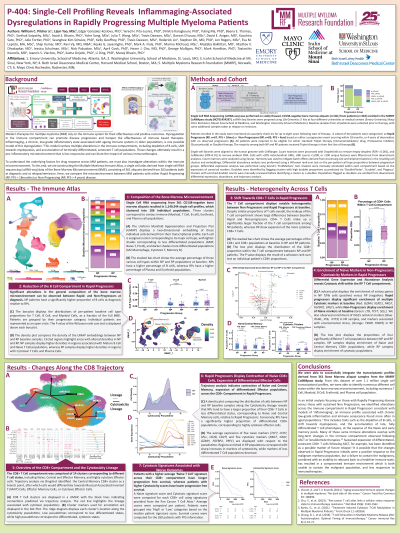Myeloma Microenvironment and immune profiling
Poster Session 3
P-404: Single-Cell Profiling Reveals Inflammaging-Associated Dysregulations in Rapidly Progressing Multiple Myeloma Patients
Friday, September 29, 2023
1:15 PM - 2:15 PM EEST


William C. Pilcher, Jr., BSE
Graduate Student
Emory University
Atlanta, Georgia, United States
Introduction: Modern therapies for multiple myeloma (MM) rely on the immune system for their effectiveness and positive outcomes. Dysregulation in the immune compartment can promote disease progression and hamper the effectiveness of immune-based therapies. In this study for the characterization of bone marrow (BM) and its association with the kinetics of MM (Rapid Progression (RPs) = PFS < 18 months, non-progression (NPs) = PFS>4 years), we performed Single Cell Profiling on BM samples from the Multiple Myeloma Research Foundation CoMMpass cohort.
Methods: Frozen CD138 negative fraction of BM samples from MM patients enrolled in the CoMMpass clinical trial (NCT01454297) underwent scRNA-seq at four different medical centers/Universities. ScRNA-seq data from 361 BM samples of 263 MM patients, collected at different time points (263 disease diagnosis (Dx), 59 relapses, 32 remissions, 7 other) were generated in phase I of the study. The scRNA-seq data were aligned and quality-controlled, doublet filtered, normalized, and batch-corrected before unsupervised and supervised analysis. The statistical analysis of annotated cellular clusters comparing RPs and NPs identified cell types, genes, and pathways associated with rapid progression.
Results: ScRNA-seq on BM samples collected at Dx from 263 MM patients generated high-quality profiles of 886,329 cells. The unsupervised analysis yielded 106 clusters corresponding to myeloid, lymphoid, and erythroid lineages. The cellular proportion analysis comparing rapid progressors (n=67) and non-progressors (n=83) depicted significant differences (P < 0.05) in cellular enrichments in the T/NK, B, and myeloid cell compartments. Focused analysis on the T cell compartment (504,417 cells) depicted significant enrichment of mature cytotoxic populations expressing cytolytic markers (GZMH, GZMB, FGFBP2) in RPs (P < 0.01) and enrichment of CD4+ and CD8+ central memory (IL7R, TRADD, TIMP1) (P < 0.04) in the NPs. The NPs also showed enrichment of multiple T cell clusters with activation of the ISG15 antiviral pathway (ISG15, MX1, IFI44L) (P < 0.03). Differential expression analysis depicted significant (BH adj. P< 0.01) over-expression of TXNIP and FKBP5 in RPs as compared to NPs in T lymphocytes, associated with poor prognosis (HR>1, P< 0.01), while NPs display significant enrichment of naïve markers (LTB, SELL, TCF7) associated with better outcomes. RP-enriched, GZMB+ cellular populations also lacked CD27 and CD28 expression, suggesting they are terminally and clonally expanded effector cells.
Conclusions: Based on single-cell findings, the expansion of a senescent CD8+ effector population along with the reduction of the memory T cell population might be resulting in a lower effectiveness of immunotherapies in rapid progressors. This in-depth characterization of the BM microenvironment might assist in developing further therapies directed toward rapid progressors with inflammaging immune ecosystems.
Methods: Frozen CD138 negative fraction of BM samples from MM patients enrolled in the CoMMpass clinical trial (NCT01454297) underwent scRNA-seq at four different medical centers/Universities. ScRNA-seq data from 361 BM samples of 263 MM patients, collected at different time points (263 disease diagnosis (Dx), 59 relapses, 32 remissions, 7 other) were generated in phase I of the study. The scRNA-seq data were aligned and quality-controlled, doublet filtered, normalized, and batch-corrected before unsupervised and supervised analysis. The statistical analysis of annotated cellular clusters comparing RPs and NPs identified cell types, genes, and pathways associated with rapid progression.
Results: ScRNA-seq on BM samples collected at Dx from 263 MM patients generated high-quality profiles of 886,329 cells. The unsupervised analysis yielded 106 clusters corresponding to myeloid, lymphoid, and erythroid lineages. The cellular proportion analysis comparing rapid progressors (n=67) and non-progressors (n=83) depicted significant differences (P < 0.05) in cellular enrichments in the T/NK, B, and myeloid cell compartments. Focused analysis on the T cell compartment (504,417 cells) depicted significant enrichment of mature cytotoxic populations expressing cytolytic markers (GZMH, GZMB, FGFBP2) in RPs (P < 0.01) and enrichment of CD4+ and CD8+ central memory (IL7R, TRADD, TIMP1) (P < 0.04) in the NPs. The NPs also showed enrichment of multiple T cell clusters with activation of the ISG15 antiviral pathway (ISG15, MX1, IFI44L) (P < 0.03). Differential expression analysis depicted significant (BH adj. P< 0.01) over-expression of TXNIP and FKBP5 in RPs as compared to NPs in T lymphocytes, associated with poor prognosis (HR>1, P< 0.01), while NPs display significant enrichment of naïve markers (LTB, SELL, TCF7) associated with better outcomes. RP-enriched, GZMB+ cellular populations also lacked CD27 and CD28 expression, suggesting they are terminally and clonally expanded effector cells.
Conclusions: Based on single-cell findings, the expansion of a senescent CD8+ effector population along with the reduction of the memory T cell population might be resulting in a lower effectiveness of immunotherapies in rapid progressors. This in-depth characterization of the BM microenvironment might assist in developing further therapies directed toward rapid progressors with inflammaging immune ecosystems.
